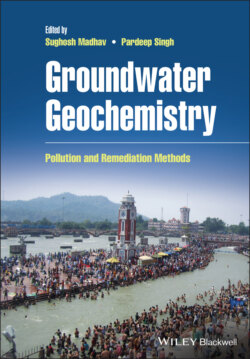Читать книгу Groundwater Geochemistry - Группа авторов - Страница 2
Table of Contents
Оглавление1 Cover
2 Title Page
3 Copyright Page
4 Preface
5 About the Editors
6 List of Contributors
7 1 Geogenic Pollutants in Groundwater and Their Removal Techniques 1.1 Introduction 1.2 Arsenic 1.3 Fluoride 1.4 Salinity (Na and Cl) 1.5 Sulphate 1.6 Heavy Metals 1.7 Selenium 1.8 Conclusion References
8 2 Fluoride Contamination in Groundwater, Impacts, and Their Potential Remediation Techniques 2.1 Introduction 2.2 Source of Fluoride in the Environment 2.3 Occurrence of Fluoride in the World and India 2.4 Effects of Fluoride on Human Health 2.5 Remediation Techniques for Fluoride Contamination 2.6 Conclusion and Future Perspective References
9 3 Salinity Problems in Groundwater and Management Strategies in Arid and Semi‐arid Regions 3.1 Introduction 3.2 Problem of Salinity 3.3 Sources of Aquifer Salinity 3.4 Types of Salinity 3.5 Effects on Agriculture 3.6 Effects on Non‐Agricultural Lands and Other Natural Resources 3.7 Effects of Saline Water on Human Health 3.8 Management Strategies 3.9 Conclusions References
10 4 Heavy Metal Contamination in Groundwater Sources 4.1 Introduction 4.2 Sources of Heavy Metal Contamination 4.3 Types of Water Pollution 4.4 Effects on the Human Body 4.5 Recent Strategies to Control Heavy Metals 4.6 Remediation Methods of Heavy Metals 4.7 Conclusion and Future Aspects References
11 5 Source, Assessment, and Remediation of Metals in Groundwater 5.1 Introduction 5.2 Sources of Contamination 5.3 Pathways of Contamination 5.4 Monitoring and Assessment Tools 5.5 Remediation Methods 5.6 Summary References
12 6 Nitrate Pollution in Groundwater and Their Possible Remediation Through Adsorption 6.1 Introduction 6.2 Sources of Nitrate in Groundwater 6.3 Standards of Nitrate for Drinking Water 6.4 High Nitrate Concentrations in Drinking Water and Their Impact on Human Health 6.5 Techniques for Nitrate Removal from Water 6.6 Challenges in Using Organic Adsorbentor Resin‐Based Ion Exchangers 6.7 Inorganic Materials Used in the Removal of Nitrate from Aqueous Solutions 6.8 Concluding Remarks References
13 7 Organic Micropollutants in Groundwater 7.1 Introduction 7.2 Types of Organic Micropollutants 7.3 Organic Micropollutants in Indian Groundwater 7.4 Organic Micropollutant Sources and Transportation Pathways 7.5 Fate of Organic Micropollutants in Groundwater 7.6 Organic Micropollutant Analysis in Groundwater 7.7 Conclusions and Future Strategies References
14 8 Organic Pollutants in Groundwater Resource 8.1 Introduction 8.2 Types of Organic Contaminants in Groundwater 8.3 Sources of Organic Contaminants in the Groundwater 8.4 Fate of Organic Contaminants in the Groundwater 8.5 Health Effects of Organic Contaminants 8.6 Conclusion References
15 9 Organic Pollutants of Global Concern in Groundwater Resources and Remediation Measures Nomenclature 9.1 Introduction to Organic Pollutants in Groundwater Resources 9.2 Organic Groundwater Pollutants: Types, Physical and Chemical Characteristics, and Associated Hazards 9.3 OPs Remediation Methods 9.4 Advanced Treatment Processes (ATPs): Theory, General Aspects, Advantages, Disadvantages, and Reported Researches 9.5 Conclusion References
16 10 Impact of Industrial Effluents on Groundwater 10.1 Introduction 10.2 Industrial Effluents Affecting the Groundwater Quality 10.3 Groundwater Contamination by Industrial Effluents: Case Study 10.4 Recommendation for Industrial Effluent Management: A Circular Economy Approach 10.5 Summary References
17 11 Impact on Groundwater Quality Resources Due to Industrial Effluent 11.1 Introduction 11.2 Quantity of Groundwater in India 11.3 Characterization of Groundwater Quality 11.4 Impacts of Industrial Activity on Groundwater in India 11.5 Industrial Structure and Industrial Pollution in India 11.6 Grossly Polluting Industries (GPIs) in India 11.7 Various Kinds of Pollutants Released by Different Industries 11.8 Current Status of Ground and Surface Water Pollution by Indian Industries 11.9 Groundwater Recharge Movement in India 11.10 Legislation, Policy Framework, and Challenges 11.11 Industrial Water Regulations 11.12 Conclusion References
18 12 Effects of Acid Mine Drainage on Hydrochemical Properties of Groundwater and Possible Remediation 12.1 Introduction 12.2 Processes for AMD Generation 12.3 Effect of AMD on Groundwater Quality 12.4 Treatment Technologies for AMD 12.5 Conclusion References
19 13 Impact of Electronic Waste Pollutants on Underground Water 13.1 Introduction 13.2 Recycling of e‐waste 13.3 Pollutants in e‐waste 13.4 Groundwater Quality 13.5 Global Scenario of e‐waste Generation 13.6 Evaluation of Genotoxic Effect of Groundwater 13.7 Effect on Underground Life Forms 13.8 Groundwater Remediation 13.9 Conclusion References
20 14 Zero‐Valent Iron (ZVI) for Groundwater Remediation 14.1 Introduction 14.2 Removal Mechanism Using ZVI 14.3 Groundwater Contaminants and their Removal by ZVI 14.4 Advantages and Limitations of ZVI 14.5 Recent Advances and Prospects in ZVI 14.6 Conclusions References
21 15 Various Purification Techniques of Groundwater 15.1 Introduction 15.2 Sources of Heavy Metals in Groundwater Pollution 15.3 Heavy Metal Effects on Environment and Human Health 15.4 Methods for Purification of Groundwater 15.5 Summary Acknowledgement Financial and Ethical Disclosures References
22 16 Various Remediation Measures for Groundwater Contamination 16.1 Introduction 16.2 Conventional Techniques for Groundwater Contamination Remediation 16.3 Nanotechnological Advancements in the Groundwater Contamination Remediation: Nanoremediation 16.4 Conclusion References
23 17 Various Remediation Measures for Groundwater Contamination 17.1 Introduction 17.2 Ex‐Situ and In‐Situ Remediation 17.3 Methods of Groundwater Remediation 17.4 Conclusion References
24 18 Exploration of Water Resources Using Remote Sensing and Geographic Information System 18.1 Introduction 18.2 Methods for Groundwater Mapping 18.3 Conclusion References
25 19 Recent Trends in Groundwater Conservation and Management 19.1 Introduction 19.2 Occurrence of Groundwater 19.3 Factors Affecting Availability of Groundwater 19.4 Hydrogeological Setup of India 19.5 Hydrological Conditions and Farming Systems 19.6 Groundwater Resource Management 19.7 Groundwater Development Prospects in India 19.8 Groundwater Conservation 19.9 Conclusions Acknowledgement References
26 20 Groundwater Vulnerability Assessment Using Random Forest Approach in a Water‐Stressed Paddy Cultivated Region of West Bengal, India 20.1 Introduction 20.2 Materials and Methods 20.3 Results 20.4 Discussion 20.5 Concluding Remarks References
27 Index
28 End User License Agreement
